Summer Research Internship
Applications will open on January 3rd, 2022 and close on February 1st, 2022. Applications will be available on this page. This is an evolving list of mentors and projects, and new entries may be added prior to the opening date; be sure to check back here before submitting an application! Contact FHL Academic Services Manager Mason Wiley (masonfhl@uw.edu) with any questions.
Note: FHL is waiting to hear back from several funding sources, which may have an impact on how many internships will be available for these projects. We should have final confirmation by the end of February . Please check this page for updates or write to Mason Wiley.
1. Seagrass Ecology Internship
Harvell Lab
 We are seeking an undergraduate intern to work on intertidal seagrass ecology projects this summer at the University of Washington’s Friday Harbor Laboratories. The main focus of the internship will be projects related to seagrass wasting disease, an infectious disease caused by the pathogen Labyrinthula zosterae (Lz). This pathogen contributes to significant seagrass declines in the San Juan Islands, WA. We will conduct a range of field and lab experiments exploring pathogen transmission dynamics, including but not limited to: seasonal infection development and disease monitoring in the field and experiments exploring the role of herbivores in transmitting Lz. These projects are part of a multi-year effort to better understand how Lz spreads in natural eelgrass meadows and broadly has conservation implications for the sustainability of regional seagrass meadows. Interns will gain experience in experimental design, intertidal sampling methods, laboratory processing of seagrass samples, and data analysis, including working with in situ temperature logger data. There may also be an opportunity to learn molecular methods (DNA extractions, qPCR).
We are seeking an undergraduate intern to work on intertidal seagrass ecology projects this summer at the University of Washington’s Friday Harbor Laboratories. The main focus of the internship will be projects related to seagrass wasting disease, an infectious disease caused by the pathogen Labyrinthula zosterae (Lz). This pathogen contributes to significant seagrass declines in the San Juan Islands, WA. We will conduct a range of field and lab experiments exploring pathogen transmission dynamics, including but not limited to: seasonal infection development and disease monitoring in the field and experiments exploring the role of herbivores in transmitting Lz. These projects are part of a multi-year effort to better understand how Lz spreads in natural eelgrass meadows and broadly has conservation implications for the sustainability of regional seagrass meadows. Interns will gain experience in experimental design, intertidal sampling methods, laboratory processing of seagrass samples, and data analysis, including working with in situ temperature logger data. There may also be an opportunity to learn molecular methods (DNA extractions, qPCR).
As this internship will involve substantial fieldwork, the intern will be immersed in the intertidal environment. The ideal applicant will be detail-oriented, enjoy working on team, and, most importantly, be enthusiastic about marine ecology! Experience working in aquatic/intertidal environments is a plus but not required.
2. Mussel Behavior & Physiology in Dynamic Coastal Environments
Dr. Emily Carrington, University of Washington
Dr. Matt Reidenbach, University of Virginia
Kelsey O’Donnell, University of Virginia
 This project investigates how dense aggregations of marine organisms alter their local water chemistry, and how these microscale alterations feedback to affect the organisms’ interactions in dynamic coastal ecosystems. The research focuses on bivalve mussels, foundation species that form dense ‘beds’ typically known for facilitating other species by ameliorating harsh flow conditions. The ability to aggregate can become a liability, however, if flow is not sufficient to flush the interstitial spaces and steep, metabolically-driven concentration gradients develop. We will use a suite of field and laboratory techniques to investigate how various mussel behaviors (such as filtration, gaping and byssal thread production) respond to and/or create corrosive chemical microclimates (such as low oxygen or low pH). The research addresses a global societal concern, the impact of anthropogenic climate change on coastal marine ecosystems, and has potential applications to aquaculture by informing adaptation strategies to “future-proof” mussel farms in the face of climate change.
This project investigates how dense aggregations of marine organisms alter their local water chemistry, and how these microscale alterations feedback to affect the organisms’ interactions in dynamic coastal ecosystems. The research focuses on bivalve mussels, foundation species that form dense ‘beds’ typically known for facilitating other species by ameliorating harsh flow conditions. The ability to aggregate can become a liability, however, if flow is not sufficient to flush the interstitial spaces and steep, metabolically-driven concentration gradients develop. We will use a suite of field and laboratory techniques to investigate how various mussel behaviors (such as filtration, gaping and byssal thread production) respond to and/or create corrosive chemical microclimates (such as low oxygen or low pH). The research addresses a global societal concern, the impact of anthropogenic climate change on coastal marine ecosystems, and has potential applications to aquaculture by informing adaptation strategies to “future-proof” mussel farms in the face of climate change.
3. Wiggin’ Out: Social and Reproductive Behaviors or the Maritime Earwig
Dr. Vikram Iyengar, Villanova University
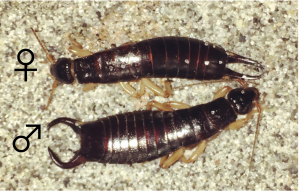 My research involves the behavior of arthropods, a highly abundant group whose extraordinary evolutionary success can be partly attributed to the remarkable diversity of their mating systems. Sexual selection, defined as differences in reproductive success due to competition for mates, often manifests itself in morphological differences between sexes (i.e., sexually-dimorphic traits) as the result of female choice for male traits, male-male battles for females, or a combination of both. The maritime earwig (Anisolabis maritima) is an insect well-suited for such behavioral studies because males differ markedly from females in body size (males are more variable in size, and often larger, than females) and weaponry (males possess asymmetrical, curved forceps whereas females have straight forceps). Sex, body size and forceps play important roles in interactions among earwigs, and A. maritima males and females differ fundamentally in their aggression towards conspecifics. Males typically resolve their disputes non-lethally by squeezing each other’s abdomens as a means to assess size, strength and fighting ability. Females, on the other hand, often kill conspecifics while vigorously guarding their nests, and larger females defend their eggs against conspecific cannibalism more effectively. This summer we will continue lab and field investigations of the social and reproductive behavior of the maritime earwig by observing same-sex and mixed-sex groups to examine how sex, size and weaponry affect group dynamics and social networks.
My research involves the behavior of arthropods, a highly abundant group whose extraordinary evolutionary success can be partly attributed to the remarkable diversity of their mating systems. Sexual selection, defined as differences in reproductive success due to competition for mates, often manifests itself in morphological differences between sexes (i.e., sexually-dimorphic traits) as the result of female choice for male traits, male-male battles for females, or a combination of both. The maritime earwig (Anisolabis maritima) is an insect well-suited for such behavioral studies because males differ markedly from females in body size (males are more variable in size, and often larger, than females) and weaponry (males possess asymmetrical, curved forceps whereas females have straight forceps). Sex, body size and forceps play important roles in interactions among earwigs, and A. maritima males and females differ fundamentally in their aggression towards conspecifics. Males typically resolve their disputes non-lethally by squeezing each other’s abdomens as a means to assess size, strength and fighting ability. Females, on the other hand, often kill conspecifics while vigorously guarding their nests, and larger females defend their eggs against conspecific cannibalism more effectively. This summer we will continue lab and field investigations of the social and reproductive behavior of the maritime earwig by observing same-sex and mixed-sex groups to examine how sex, size and weaponry affect group dynamics and social networks.
4. How persistent are eelgrass patches? A paleocological pilot study in False Bay, WA
Dr. Sandy Wyllie-Echeverria, Friday Harbor Laboratories, University of Washington
Dr. Bruce Finney, Idaho State University
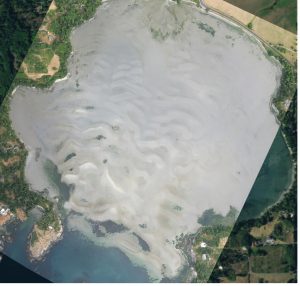
Zostera marina (eelgrass) is the dominant seagrass species in the Northern Hemisphere. In western North America these marine flowering plants grow in soft-bottom estuarine and coastal environments from Alaska to Baja California, and probably occupied these environments since the Pliocene. The objective of this REU is to determine the persistence of an eelgrass population near the proximal center of this distribution. Our site False Bay, San Juan Island, is a shallow water bay that lies within the Salish Sea region of Washington State and is a marine reserve managed by the Friday Harbor Laboratories, University of Washington.
This project will explore the persistence of eelgrass patches using paleoecological methods. We will obtain a transect of cores across a gradient of patch persistence and use carbon isotopes (d13C) as a proxy for eelgrass abundance. As the d13C of eelgrass is higher than other sources of organic matter to sediments, it will serve as a tracer of eelgrass presence. This project will produce data to explore the hypothesis that downcore changes in d13C reflect changes in eelgrass abundance over time.
5. Effects of Temperature Across the Life Cycle of Kelp
Dr. Brooke Weigel, Friday Harbor Labs, University of Washington
 Bull kelp (Nereocystis luetkeana) forests have been declining over the last century in some areas of the Salish Sea, particularly in South Puget Sound. One major environmental stressor for bull kelp is high seawater temperatures, as bull kelp thrive in very cold waters from central California through Alaska. Sea surface temperatures are increasing globally, yet we are just beginning to understand the consequences of ocean warming for kelp forest ecosystems. Bull kelp have a biphasic life cycle with two very distinct free-living stages: a large diploid sporophyte, which can reach the surface of the ocean at heights of up to 30 m, and microscopic haploid gametophytes, which live on the bottom of the ocean. Temperature stress can impact the entire life cycle of bull kelp, from zoospore release and settlement to gametophyte growth and sexual reproduction. Despite the importance of knowing the thermal tolerance limits of this ecologically important species, there are many knowledge gaps about the effects of temperature on the life cycle of bull kelp. Using a combination of fieldwork to collect reproductive kelp and lab work to culture kelp gametophytes under temperature-controlled experiments, this REU project will explore the impacts of temperature across the life cycle of bull kelp. Excitement about collecting kelp in the field (from boats), growing kelp in the lab, and using microscopes to examine their growth rates is beneficial for this project.
Bull kelp (Nereocystis luetkeana) forests have been declining over the last century in some areas of the Salish Sea, particularly in South Puget Sound. One major environmental stressor for bull kelp is high seawater temperatures, as bull kelp thrive in very cold waters from central California through Alaska. Sea surface temperatures are increasing globally, yet we are just beginning to understand the consequences of ocean warming for kelp forest ecosystems. Bull kelp have a biphasic life cycle with two very distinct free-living stages: a large diploid sporophyte, which can reach the surface of the ocean at heights of up to 30 m, and microscopic haploid gametophytes, which live on the bottom of the ocean. Temperature stress can impact the entire life cycle of bull kelp, from zoospore release and settlement to gametophyte growth and sexual reproduction. Despite the importance of knowing the thermal tolerance limits of this ecologically important species, there are many knowledge gaps about the effects of temperature on the life cycle of bull kelp. Using a combination of fieldwork to collect reproductive kelp and lab work to culture kelp gametophytes under temperature-controlled experiments, this REU project will explore the impacts of temperature across the life cycle of bull kelp. Excitement about collecting kelp in the field (from boats), growing kelp in the lab, and using microscopes to examine their growth rates is beneficial for this project.
6. Thermal Stress on the Shore: Physiological Performance of Solitary Versus Aggregated Mussels
Dr. Michael Nishizaki, Carleton College
 In this age of climate change, the biological impacts of rising temperatures have been documented in terrestrial, freshwater, and marine ecosystems around the world. These effects are especially evident on intertidal shores, where organisms commonly live near their thermal limits. On San Juan Island, we focus on mytilid mussels, a foundation species that forms dense ‘beds’ typically known for facilitating other species by ameliorating harsh flow conditions. This ability may become a liability, however, if flow is not sufficient to flush the interstitial spaces and metabolically-driven concentration gradients develop. This project will assess the potentially interactive effects multiple environmental factors (e.g., water temperature and flow) on the physiological performance (e.g., respiration rates) of solitary mussels versus those in aggregation. From a societal perspective, the results will help address how anthropogenic climate change may or may not affect the health of mussel aggregations in natural populations or in aquacultural mussel farms.
In this age of climate change, the biological impacts of rising temperatures have been documented in terrestrial, freshwater, and marine ecosystems around the world. These effects are especially evident on intertidal shores, where organisms commonly live near their thermal limits. On San Juan Island, we focus on mytilid mussels, a foundation species that forms dense ‘beds’ typically known for facilitating other species by ameliorating harsh flow conditions. This ability may become a liability, however, if flow is not sufficient to flush the interstitial spaces and metabolically-driven concentration gradients develop. This project will assess the potentially interactive effects multiple environmental factors (e.g., water temperature and flow) on the physiological performance (e.g., respiration rates) of solitary mussels versus those in aggregation. From a societal perspective, the results will help address how anthropogenic climate change may or may not affect the health of mussel aggregations in natural populations or in aquacultural mussel farms.
7. Animal Behavior in Marine Terrestial Environments
Dr. Amy Cook, The Evergreen State College
One of the greatest challenges animal behaviorists face is observing their subjects in the wild. However, San Juan Island offers opportunities to make detailed observations of the behavior of a variety of animals in the field with relative ease. My mentees will learn the techniques of studying behavior in the field including how to describe behaviors, sampling and recording methodologies, and data collection and analysis. Once they are comfortable with the methodology, my mentees can apply the field behavior techniques they learned to one of the following projects –behavior in Pigeon Guillemots or the behavior of juvenile tidepool sculpins (Oligocottus maculotus) in intertidal pools. Animal behavior intersects with conservation biology, ecology, and evolutionary biology and we will discuss these connections in regular research seminars. On San Juan Island, the interaction between human behavior and the behavior of other animals is an important factor in many of our study systems. This project will benefit mentees interested in pursuing a careers or advanced study in animal behavior, field ecology, or conservation biology.
8. Environmental Stress Response in a Marine Tunicate
Dr. Alison Gardell, University of Washington Tacoma
 Botryllus schlosseri is a very common encrusting colonial sea squirt that is native to the Mediterranean Sea and Atlantic coast of Europe. It has spread globally into shallow water temperate waters, which includes both coasts of North America. B. schlosseri encounters a range of environmental salinities in its natural environment, and consequently, must either tolerate or compensate for perturbations in body volume caused by salinity changes. Compatible osmolytes are small molecules that are synthesized in response to osmotic (salinity) stress and serve to regulate cell volume. To date, there is very limited research regarding the regulation of osmolytes in marine tunicates. Taurine is an important organic osmolyte in numerous species (invertebrates, fishes and mammals). Intracellular taurine content is regulated through gene expression of the taurine transmembrane transporter (TauT).The hypothesis for this project is that transcriptional regulation of compatible osmolyte genes is important for response of B. schlosseri to a fluctuating environmental salinity. Specifically, it is predicted that TauT plays a role in adjusting the concentration of taurine in response to altered salinity environments. Pre- and post-exposure tissue extracts from B. schlosseri will be analyzed for targeted gene expression assays using quantitative real-time PCR. Students involved in this project will regularly collect colonial tunicates at FHL, maintain a healthy lab culture, perform salinity challenge experiments, and gain experience in molecular techniques required to assay for gene expression.
Botryllus schlosseri is a very common encrusting colonial sea squirt that is native to the Mediterranean Sea and Atlantic coast of Europe. It has spread globally into shallow water temperate waters, which includes both coasts of North America. B. schlosseri encounters a range of environmental salinities in its natural environment, and consequently, must either tolerate or compensate for perturbations in body volume caused by salinity changes. Compatible osmolytes are small molecules that are synthesized in response to osmotic (salinity) stress and serve to regulate cell volume. To date, there is very limited research regarding the regulation of osmolytes in marine tunicates. Taurine is an important organic osmolyte in numerous species (invertebrates, fishes and mammals). Intracellular taurine content is regulated through gene expression of the taurine transmembrane transporter (TauT).The hypothesis for this project is that transcriptional regulation of compatible osmolyte genes is important for response of B. schlosseri to a fluctuating environmental salinity. Specifically, it is predicted that TauT plays a role in adjusting the concentration of taurine in response to altered salinity environments. Pre- and post-exposure tissue extracts from B. schlosseri will be analyzed for targeted gene expression assays using quantitative real-time PCR. Students involved in this project will regularly collect colonial tunicates at FHL, maintain a healthy lab culture, perform salinity challenge experiments, and gain experience in molecular techniques required to assay for gene expression.
9. Biotic and Abiotic Factors Influencing Kelp Bed Communities in the Salish Sea
Dr. Katie Dobkowski, Bates College and Friday Harbor Labs, University of Washington

I study marine community ecology and especially focus on foundation species such bull kelp (Nereocystis luetkeana). Nereocystis is an annual kelp species that provides the bulk of the complex three-dimensional habitat space in rocky subtidal habitats of the San Juan Islands and elsewhere in Washington State. There are a variety of potential summer projects that focus on investigating biotic and abiotic factors influencing bull kelp across their complicated life history using a combination of lab and field work. Topics of interest include Northern kelp crab (Pugettia producta) and graceful kelp crab (P. gracilis) feeding preferences (in the lab) and distribution and abundance (in the field; intertidal, snorkel or SCUBA surveys); contribution of P. producta feces to detrital food webs (in the lab, using field-collected intertidal copepod Tigriopus californicus); and the effects of changing ocean conditions, such as temperature, on invertebrate feeding rates (urchins, kelp crabs). Subtidal data collection using SCUBA may be possible for a student who is already a trained scientific diver at an AAUS member institution, but diving OR snorkeling is NOT a requirement for any of these projects, very successful field data collection can happen on the shore or from boats as well! A better understanding of the dynamics and interactions of N. luetkeana beds in the Salish Sea is crucial not only because they create valuable habitat for economically and ecologically important species, but also to inform management decisions and restoration efforts in a changing ocean.
10. Potential Effects of Environmental Change on Sea Star Larval Feeding
Dr. Sophie George, Georgia Southern University
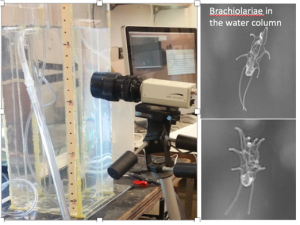 Discharge from the Fraser River into the Salish Sea in the Pacific Northwest peaks during the spring and summer when larvae of the sea star Pisaster ochraceus are developing in the water column. Due to increasing temperatures and the recent mass mortality of sea stars, how larvae of this species respond to fluctuations in temperature and salinity during development, has been of interest in our lab. During summer 2019 and 2020 we investigated whether the swimming behaviors of bipinnariae and brachiolariae of this species differ when exposed to different salinity (20 and 30‰) and temperature (16 or 19°C) combinations in the presence and absence of food at the halocline. We discovered that bipinnariae increased their swimming speeds and turning rates at high temperatures. This raises the question as to whether faster swimming speeds and turning rates translates into higher ingestion rates. During this summer, students will examine the effects of a food patch at the halocline on larval swimming speeds, time spent feeding, and ingestion rates. Students involved in this project will gain experience in designing experiments, culturing echinoderm larvae, sampling techniques, and collecting and analyzing data using R and/or Python. The results will give us an idea of the effect of increased sea surface temperatures on larval feeding and swimming by a key stone species in the Pacific Northwest.
Discharge from the Fraser River into the Salish Sea in the Pacific Northwest peaks during the spring and summer when larvae of the sea star Pisaster ochraceus are developing in the water column. Due to increasing temperatures and the recent mass mortality of sea stars, how larvae of this species respond to fluctuations in temperature and salinity during development, has been of interest in our lab. During summer 2019 and 2020 we investigated whether the swimming behaviors of bipinnariae and brachiolariae of this species differ when exposed to different salinity (20 and 30‰) and temperature (16 or 19°C) combinations in the presence and absence of food at the halocline. We discovered that bipinnariae increased their swimming speeds and turning rates at high temperatures. This raises the question as to whether faster swimming speeds and turning rates translates into higher ingestion rates. During this summer, students will examine the effects of a food patch at the halocline on larval swimming speeds, time spent feeding, and ingestion rates. Students involved in this project will gain experience in designing experiments, culturing echinoderm larvae, sampling techniques, and collecting and analyzing data using R and/or Python. The results will give us an idea of the effect of increased sea surface temperatures on larval feeding and swimming by a key stone species in the Pacific Northwest.
11. Diversity of Fishes in Pacific NW Fishes
Dr. Gareth Fraser, University of Florida
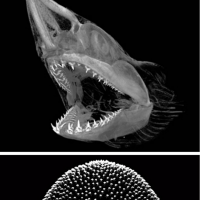 Teeth are incredibly diverse craniofacial structures in vertebrates. Fishes have an immense variety of dentitions, tooth shapes, dental location and tooth replacement mechanisms. This project aims to address the diversity of teeth in the fishes of the NW Pacific, taking particular advantage of the wealth of diversity around the San Juan Islands, and can include many members of the wider fish clade from jawless fishes (Cyclostomes; hagfish and lampreys), cartilaginous fishes (Chondrichthyes; sharks, rays and chimeras), to the bony fishes (Osteichthyes).
Teeth are incredibly diverse craniofacial structures in vertebrates. Fishes have an immense variety of dentitions, tooth shapes, dental location and tooth replacement mechanisms. This project aims to address the diversity of teeth in the fishes of the NW Pacific, taking particular advantage of the wealth of diversity around the San Juan Islands, and can include many members of the wider fish clade from jawless fishes (Cyclostomes; hagfish and lampreys), cartilaginous fishes (Chondrichthyes; sharks, rays and chimeras), to the bony fishes (Osteichthyes).
For this project we aim to use modern (3D imaging/CT) and classical techniques (histology/clearing/live staining) to compare the naturally diverse marine fauna to established models to most effectively address questions in evolutionary developmental biology. This project will uncover novel aspects of dental diversity in understudied fishes collected at Friday Harbor Laboratories. The waterways of the NW Pacific are wonderfully productive and a vast variety of fishes can be collected and studied for this project.
12. Sea Urchin Adhesion in Changing Environmental Conditions
Dr. Carla A Narvaez, Friday Harbor Labs, University of Washington
 Sea urchins are key members of habitats exposed to intense hydrodynamic forces, such as currents and waves. In these high-energy environments, strong adhesion is essential for survival. Sea urchins secure themselves to the substrate, walk, and catch food by coordinating the adhesion of hundreds of fleshy extensions, called tube feet. At the distal end of a tube foot, there is a disc, similar to an octopus sucker. However, adhesion occurs when the flattened disc releases adhesive and de-adhesive secretions, so sea urchins stick, don’t suck!. Attachment strength is influenced by the number of tube feet used to adhere, glue chemistry, and mechanical properties, and morphology of the tube foot. The project will assess the effect of acute environmental stressors (e.g. temperature, salinity) on the adhesive performance of intertidal and subtidal populations of sea urchins in the San Juan Islands (Strongylocentrotus purpuratus, S. droebachiensis, Mesocentrotus franciscanus). Understanding the plasticity of urchins’ adhesion is important to determine the influence of environmental conditions on ecological processes including settlement, herbivory, competition, and predator-prey interactions.
Sea urchins are key members of habitats exposed to intense hydrodynamic forces, such as currents and waves. In these high-energy environments, strong adhesion is essential for survival. Sea urchins secure themselves to the substrate, walk, and catch food by coordinating the adhesion of hundreds of fleshy extensions, called tube feet. At the distal end of a tube foot, there is a disc, similar to an octopus sucker. However, adhesion occurs when the flattened disc releases adhesive and de-adhesive secretions, so sea urchins stick, don’t suck!. Attachment strength is influenced by the number of tube feet used to adhere, glue chemistry, and mechanical properties, and morphology of the tube foot. The project will assess the effect of acute environmental stressors (e.g. temperature, salinity) on the adhesive performance of intertidal and subtidal populations of sea urchins in the San Juan Islands (Strongylocentrotus purpuratus, S. droebachiensis, Mesocentrotus franciscanus). Understanding the plasticity of urchins’ adhesion is important to determine the influence of environmental conditions on ecological processes including settlement, herbivory, competition, and predator-prey interactions.
I use a multidisciplinary approach that includes experiments in the laboratory and the field. Students will have the opportunity to learn about sea urchin ecology and biomechanics, experimental design, functional morphology, and data analysis. Enthusiasm for marine ecology and the ability to work as part of a team are the only requirements!
13. Imaging the Sensory Systems of the Fishes of the Pacific Northwest
Dr. Lauren Eve Simonitis, Friday Harbor Labs, University of Washington
 Fishes use an impressive suite of sensory systems to navigate and succeed in their aquatic environment. The fish species of the Pacific North West are diverse- occupying a range of ecological niches and displaying vastly different body shapes. Their sensory systems (eg- olfaction, gustation, mechanosensation, and electroreception) are equally diverse and understudied.
Fishes use an impressive suite of sensory systems to navigate and succeed in their aquatic environment. The fish species of the Pacific North West are diverse- occupying a range of ecological niches and displaying vastly different body shapes. Their sensory systems (eg- olfaction, gustation, mechanosensation, and electroreception) are equally diverse and understudied.
For this project, we aim to use imaging technologies such as DiceCT, SEM, and histology to describe and quantify sensory system morphology in various fishes collected in the waters surrounding Friday Harbor Laboratories. Particularly, we are interested in cartilaginous fish but would be willing to expand to teleosts for a motivated student. This project will fill large knowledge gaps in our current understanding of sensory biology and will provide a student with practical bio imaging skills.
14. Gut Microbiomes of Intertidal and Subtidal Fishes
Dr. Joseph Heras, California State University, San Bernardino
 In order to identify patterns of evolutionary adaptations within intertidal and subtidal systems, my lab focuses on marine fishes such as prickleback fishes (family Stichaeidae), which are best known for dietary diversity, ontogenetic dietary shifts, convergent evolution of herbivory, and independent lineages of intertidal invasions within this family. We are seeking an undergraduate student who will be involved in a project to evaluate the gut microbiome of pricklebacks, which can potentially play a key role in evolutionary adaptations within intertidal and subtidal fishes. For this study, the following intertidal species have been selected: the high cockscomb prickleback (Anoplarchus purpurescens) and the ribbon prickleback (Phytichthys chirus). In addition, two subtidal species will be evaluated, the slender cockscomb prickleback (Anoplarchus insignis) and the snake prickleback (Lumpenus sagitta). The experimental design will be to analyze the gut microbiome of wild versus lab reared individuals of all species to determine if gut microbial communities differ due to habitat, host species, or diet. During the course of the summer internship, this student will have the opportunity to gain experience in fieldwork (collecting intertidal and subtidal pricklebacks), rearing live fishes, and conducting gut microbiome extractions required to analyze microbial abundance and diversity. The ideal candidate should be interested in intertidal fieldwork, maintenance of live fishes in the lab, genomics, and bioinformatics. A student with experience in any of these areas is preferred, but not a requirement.
In order to identify patterns of evolutionary adaptations within intertidal and subtidal systems, my lab focuses on marine fishes such as prickleback fishes (family Stichaeidae), which are best known for dietary diversity, ontogenetic dietary shifts, convergent evolution of herbivory, and independent lineages of intertidal invasions within this family. We are seeking an undergraduate student who will be involved in a project to evaluate the gut microbiome of pricklebacks, which can potentially play a key role in evolutionary adaptations within intertidal and subtidal fishes. For this study, the following intertidal species have been selected: the high cockscomb prickleback (Anoplarchus purpurescens) and the ribbon prickleback (Phytichthys chirus). In addition, two subtidal species will be evaluated, the slender cockscomb prickleback (Anoplarchus insignis) and the snake prickleback (Lumpenus sagitta). The experimental design will be to analyze the gut microbiome of wild versus lab reared individuals of all species to determine if gut microbial communities differ due to habitat, host species, or diet. During the course of the summer internship, this student will have the opportunity to gain experience in fieldwork (collecting intertidal and subtidal pricklebacks), rearing live fishes, and conducting gut microbiome extractions required to analyze microbial abundance and diversity. The ideal candidate should be interested in intertidal fieldwork, maintenance of live fishes in the lab, genomics, and bioinformatics. A student with experience in any of these areas is preferred, but not a requirement.
15. Nature-based Solutions for Removing Excess Nutrients from Carbon Along Urban Waterfronts
Dr. Eliza Heery, Smithsonian Institution and Friday Harbor Laboratories, University of Washington
 We are seeking an undergraduate intern for a recently-funded project centered around urban marine ecology and green engineering. In collaboration with researchers at Chioggia Hydrobiological Station in Italy and several industry partners, the project’s overarching aim is to develop an in-situ “scrubber” system that uses stress-tolerant filamentous algae and salt marsh plants to absorb excess nutrients and carbon from urban waterways and semi-permanently sequester it in building materials like insulation and concrete/cement alternatives. The first step in the project is to determine whether the filamentous algae and salt marsh plant species targeted have high enough productivity rates in enriched, urban conditions to be effective at biosorption and carbon uptake. The undergraduate selected for this project will work collaboratively with postdocs in Friday Harbor and Chioggia on a field experiment measuring the effect of nutrient enrichment on the net primary production of scrubber-grown macrophytes. As part of the core research team, they will gain experience in field ecology, photorespirometry methods, DNA extractions, and microscopy. There is also room to expand field and/or lab methods to generate data for an side project on micro-/nanoplastic retention of filamentous algae and salt marsh plants or the ecology of their associated epifaunal invertebrates (isopods, polychaetes, etc). The protocols we develop as a team will be implemented simultaneously in Friday Harbor and Venice Lagoon, Italy, and there will be many opportunities to interface with international collaborators and industry partners.
We are seeking an undergraduate intern for a recently-funded project centered around urban marine ecology and green engineering. In collaboration with researchers at Chioggia Hydrobiological Station in Italy and several industry partners, the project’s overarching aim is to develop an in-situ “scrubber” system that uses stress-tolerant filamentous algae and salt marsh plants to absorb excess nutrients and carbon from urban waterways and semi-permanently sequester it in building materials like insulation and concrete/cement alternatives. The first step in the project is to determine whether the filamentous algae and salt marsh plant species targeted have high enough productivity rates in enriched, urban conditions to be effective at biosorption and carbon uptake. The undergraduate selected for this project will work collaboratively with postdocs in Friday Harbor and Chioggia on a field experiment measuring the effect of nutrient enrichment on the net primary production of scrubber-grown macrophytes. As part of the core research team, they will gain experience in field ecology, photorespirometry methods, DNA extractions, and microscopy. There is also room to expand field and/or lab methods to generate data for an side project on micro-/nanoplastic retention of filamentous algae and salt marsh plants or the ecology of their associated epifaunal invertebrates (isopods, polychaetes, etc). The protocols we develop as a team will be implemented simultaneously in Friday Harbor and Venice Lagoon, Italy, and there will be many opportunities to interface with international collaborators and industry partners.
16. Drag reducing armor in Pacific Spiny Lumpsuckers
Karly Cohen, Dr. Adam Summers, Dr. Cassandra Donatelli, Friday Harbor Laboratories, University of Washington
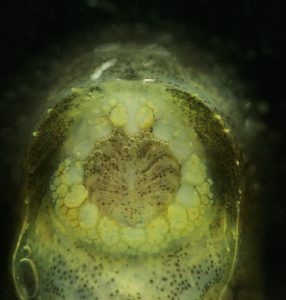 Predation, combat, and the slings and arrows of an abrasive and high impact environment, represent just some of the biotic and abiotic stressors that fishes are armored against. Pacific Spiny Lumpsuckers are charismatic and rotund fish found across the Northern Pacific Ocean and frequently caught throughout the Salish Sea. Similar to sharks, Pacific Spiny Lumpsuckers are covered in teeth – denticles protecting the fish from the stress of bouncing around the subtidal and the threat of predation. We are interested in understanding the role armor plays during swimming and sticking. The Lumpsucker is a poor swimmer in the wave swept intertidal; their lightweight armor may be a solution to the problem of collisions with abiotic stressors like rocks. Shark denticles reduce drag while they swim, helping to channel and streamline water away from their body efficiently. This type of morphology is what we often associate with drag reduction but, what if it pays to be bumpy? Changes in the topography of a surface, whether it be the slopes of sand beneath the sea or protuberances on a spikey fish, changes the speed and structure of flow.
Predation, combat, and the slings and arrows of an abrasive and high impact environment, represent just some of the biotic and abiotic stressors that fishes are armored against. Pacific Spiny Lumpsuckers are charismatic and rotund fish found across the Northern Pacific Ocean and frequently caught throughout the Salish Sea. Similar to sharks, Pacific Spiny Lumpsuckers are covered in teeth – denticles protecting the fish from the stress of bouncing around the subtidal and the threat of predation. We are interested in understanding the role armor plays during swimming and sticking. The Lumpsucker is a poor swimmer in the wave swept intertidal; their lightweight armor may be a solution to the problem of collisions with abiotic stressors like rocks. Shark denticles reduce drag while they swim, helping to channel and streamline water away from their body efficiently. This type of morphology is what we often associate with drag reduction but, what if it pays to be bumpy? Changes in the topography of a surface, whether it be the slopes of sand beneath the sea or protuberances on a spikey fish, changes the speed and structure of flow.
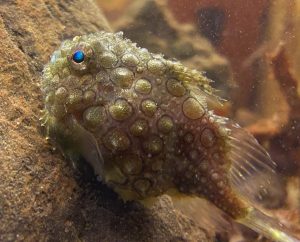 We are interested in measuring the effects that armor has on Lumpsucker hydrodynamics. In addition to their armor Lumpsuckers are characterized by a suction cup on their belly that allows them to attach to a variety of substrates including rocks, barnacles, and glass. The suction cup of Lumpsuckers develops before the armor – suggesting that smaller fish are faced with different environmental pressures than bigger fish. We hypothesize that there is a tradeoff between the size and suction force of the disc and the amount of armor. In other words, little fish prioritize suction while big fish prioritize drag reduction. To test these hypotheses we propose a myriad of methods including quantification of CT data using 3D segmentation software, CT scanning, 3D printing, and fluid dynamic studies to measure drag. The student will gather growth and morphological data on the development and size of the Lumpsucker suction disc and use CT scans to compare the growth of the disc to the growth of armor. The student will also learn to generate and print 3D models which will then be used to measure drag.
We are interested in measuring the effects that armor has on Lumpsucker hydrodynamics. In addition to their armor Lumpsuckers are characterized by a suction cup on their belly that allows them to attach to a variety of substrates including rocks, barnacles, and glass. The suction cup of Lumpsuckers develops before the armor – suggesting that smaller fish are faced with different environmental pressures than bigger fish. We hypothesize that there is a tradeoff between the size and suction force of the disc and the amount of armor. In other words, little fish prioritize suction while big fish prioritize drag reduction. To test these hypotheses we propose a myriad of methods including quantification of CT data using 3D segmentation software, CT scanning, 3D printing, and fluid dynamic studies to measure drag. The student will gather growth and morphological data on the development and size of the Lumpsucker suction disc and use CT scans to compare the growth of the disc to the growth of armor. The student will also learn to generate and print 3D models which will then be used to measure drag.
17. Functional Morphology and Biomechanics of Marine Sculpins
Dr. Emily Kane, Dr. Callie Crawford, and Olivia Hawkins, University of Louisiana at Lafayette
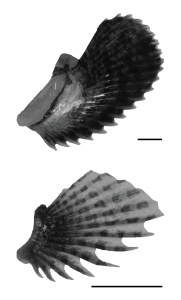 Animals are defined by their ability to move through their environment and their need to consume other organisms, but these abilities can converge, and be integrated, during prey capture. In fishes, the widespread use of suction to seize prey necessitates integration with locomotion because it only useful at close-range. However, it is unclear how and why variation in this relationship arises, for example, in relation to varying ecological demands. Pacific marine sculpins live in areas that differ in wave exposure and use modified pectoral fins to generate negative lift and grab onto rocks to maintain their position in flow. Therefore, limiting movement in this way is in direct contrast to the use of locomotor structures to propel fish during prey capture and might be expected to pose a challenge for integration. Using a combination of ecological, morphological, hydrodynamic, kinematic, and behavioral analyses, we will examine variation in form-function relationships among fish from subtidal and intertidal regions. The work undertaken during the summer 2022 will be collaborative and serve as a foundation for future work with these fish.
Animals are defined by their ability to move through their environment and their need to consume other organisms, but these abilities can converge, and be integrated, during prey capture. In fishes, the widespread use of suction to seize prey necessitates integration with locomotion because it only useful at close-range. However, it is unclear how and why variation in this relationship arises, for example, in relation to varying ecological demands. Pacific marine sculpins live in areas that differ in wave exposure and use modified pectoral fins to generate negative lift and grab onto rocks to maintain their position in flow. Therefore, limiting movement in this way is in direct contrast to the use of locomotor structures to propel fish during prey capture and might be expected to pose a challenge for integration. Using a combination of ecological, morphological, hydrodynamic, kinematic, and behavioral analyses, we will examine variation in form-function relationships among fish from subtidal and intertidal regions. The work undertaken during the summer 2022 will be collaborative and serve as a foundation for future work with these fish.
18. Automating Reactive Reward Delivery of Small Precise Volumes of Food Reward for Studying Octopus’ Behavior
Dr. David Gire and Willem L Weertman, University of Washington Department of Psychology
 Automated delivery of reward is an important tool for behavioral neuroscience. Effective reward paradigms deliver small precise repeated rewards reactively to animal behavior. Currently, there are no such effective paradigms for octopuses. The lack of effective paradigms seriously hampers the ability of researchers to ask interesting questions about octopus neuroethology. We plan to test a paradigm that utilizes live-pose estimation and syringe pumps to reactively deliver small precise volumes of food to octopuses in response to behavior. This project will involve learning acrylic fabrication, programming (Bonsai-Rx, Arduino, and python), simple electronics, and octopus’ care. Some prior experience programming in any language is recommended. If the applicant has an AAUS SCUBA authorization they will have the opportunity to participate in collection dives.
Automated delivery of reward is an important tool for behavioral neuroscience. Effective reward paradigms deliver small precise repeated rewards reactively to animal behavior. Currently, there are no such effective paradigms for octopuses. The lack of effective paradigms seriously hampers the ability of researchers to ask interesting questions about octopus neuroethology. We plan to test a paradigm that utilizes live-pose estimation and syringe pumps to reactively deliver small precise volumes of food to octopuses in response to behavior. This project will involve learning acrylic fabrication, programming (Bonsai-Rx, Arduino, and python), simple electronics, and octopus’ care. Some prior experience programming in any language is recommended. If the applicant has an AAUS SCUBA authorization they will have the opportunity to participate in collection dives.